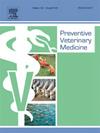行业利益相关者对猪咬尾和断尾的态度和信念-瑞士和西班牙的案例研究
IF 2.2
2区 农林科学
Q1 VETERINARY SCIENCES
引用次数: 0
摘要
尽管欧洲主要生猪生产国努力禁止这种做法,但它仍然被广泛使用。本研究旨在了解西班牙和瑞士养猪专业人士对咬尾和断尾的态度和信念。为此,n = 275名瑞士参与者和n = 87名西班牙参与者完成了一份关于猪咬尾和断尾问题以及他们的态度和信念的在线问卷。结果西班牙参与者主要饲养断尾猪(n = 70,80 %),而瑞士参与者主要饲养未断尾猪(n = 271,99 %)。虽然大多数参与者报告了过去两年的咬尾事件(n = 301,83 %),但对它们的态度不同:西班牙参与者发现管理咬尾比瑞士参与者更具挑战性。此外,西班牙参与者认为,与未入坞猪相比,入坞猪的福利更好,而瑞士参与者则认为未入坞猪的福利更好。同样,西班牙参与者也强烈地认为,与未停靠猪相比,停靠猪的生产风险更低,而瑞士参与者则没有这种看法。总的来说,与西班牙人相比,瑞士人认为养长尾猪有更多的好处,也更有可能防止咬尾。结论西班牙养猪业专业人士对断尾的态度主要是相信断尾是降低生产风险和确保动物福利的必要措施。未来实施断尾禁令的努力不仅要努力克服结构性障碍,还应注重与养猪业专业人士沟通并改变他们的观念。通过解决不愿意尝试不对接的问题,生产者可以在饲养长尾猪方面获得更多的经验和信心。为了在断尾实践中创造可持续的变化,除了优化猪的环境外,沟通应侧重于改变态度和减少风险认知。本文章由计算机程序翻译,如有差异,请以英文原文为准。
Industry stakeholders attitudes and beliefs about tail biting and docking in pigs – A case study in Switzerland and Spain
Background
Tail docking is still widely used in major European pig-producing countries despite efforts to ban it. The present study aimed to understand the attitudes and beliefs of pig farming professionals in Spain and Switzerland regarding tail biting and tail docking. For this, n = 275 Swiss, and n = 87 Spanish participants completed an online questionnaire regarding the issue of tail biting and docking in pigs and their attitudes and beliefs.
Results
Spanish participants predominantly kept docked pigs (n = 70, 80 %), whereas Swiss participants kept undocked pigs (n = 271, 99 %). While tail biting occurrences in the last two years were reported by most participants (n = 301, 83 %), the attitudes towards them differed: Spanish participants found the management of tail biting more challenging than Swiss participants. In addition, Spanish participants considered welfare to be better for docked pigs than for undocked pigs, whereas Swiss participants perceived the welfare of undocked pigs to be better. Similarly, Spanish participants showed a strong perception of lower production risks for docked pigs than for undocked pigs, a perception that could not be found in Swiss participants. Overall, Swiss participants saw more advantages in keeping long-tailed pigs and more possibilities to prevent tail biting than Spanish participants.
Conclusions
The results suggest that Spanish pig-farming professionals’ attitudes towards tail docking are dominated by the conviction that docking is a necessity that lowers production risks and ensures animal welfare. Future efforts attempting to enforce the prohibition on tail docking should not only attempt to overcome structural barriers, but also focus on communicating with and changing the perceptions of pig farming professionals. By tackling the reluctance to try non-docking, producers can gain more experience and confidence with raising long-tailed pigs. To create sustainable changes in tail-docking practices, in addition to optimising the environment for pigs, communication should focus on changing attitudes and reducing risk perceptions.
求助全文
通过发布文献求助,成功后即可免费获取论文全文。
去求助
来源期刊

Preventive veterinary medicine
农林科学-兽医学
CiteScore
5.60
自引率
7.70%
发文量
184
审稿时长
3 months
期刊介绍:
Preventive Veterinary Medicine is one of the leading international resources for scientific reports on animal health programs and preventive veterinary medicine. The journal follows the guidelines for standardizing and strengthening the reporting of biomedical research which are available from the CONSORT, MOOSE, PRISMA, REFLECT, STARD, and STROBE statements. The journal focuses on:
Epidemiology of health events relevant to domestic and wild animals;
Economic impacts of epidemic and endemic animal and zoonotic diseases;
Latest methods and approaches in veterinary epidemiology;
Disease and infection control or eradication measures;
The "One Health" concept and the relationships between veterinary medicine, human health, animal-production systems, and the environment;
Development of new techniques in surveillance systems and diagnosis;
Evaluation and control of diseases in animal populations.
 求助内容:
求助内容: 应助结果提醒方式:
应助结果提醒方式:


